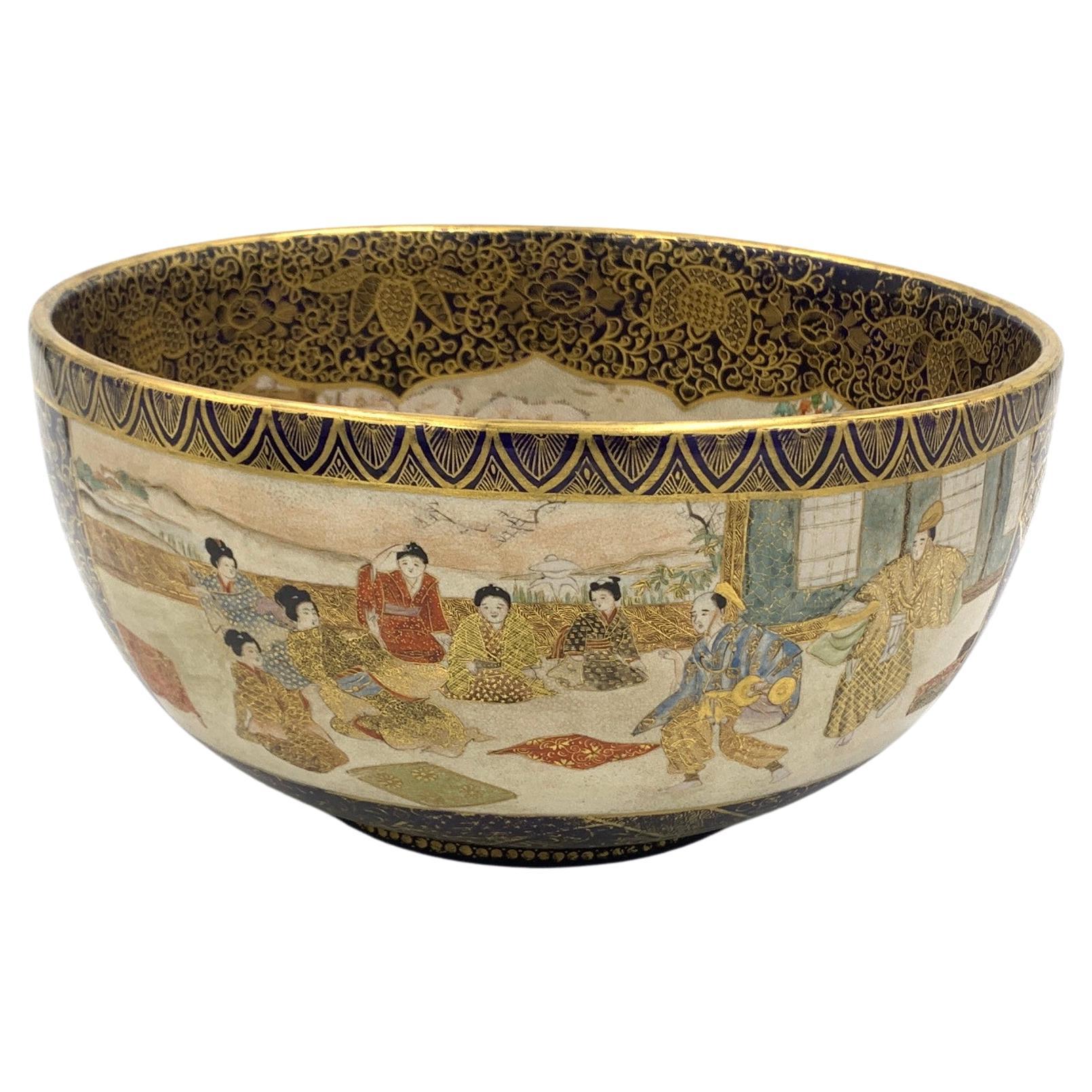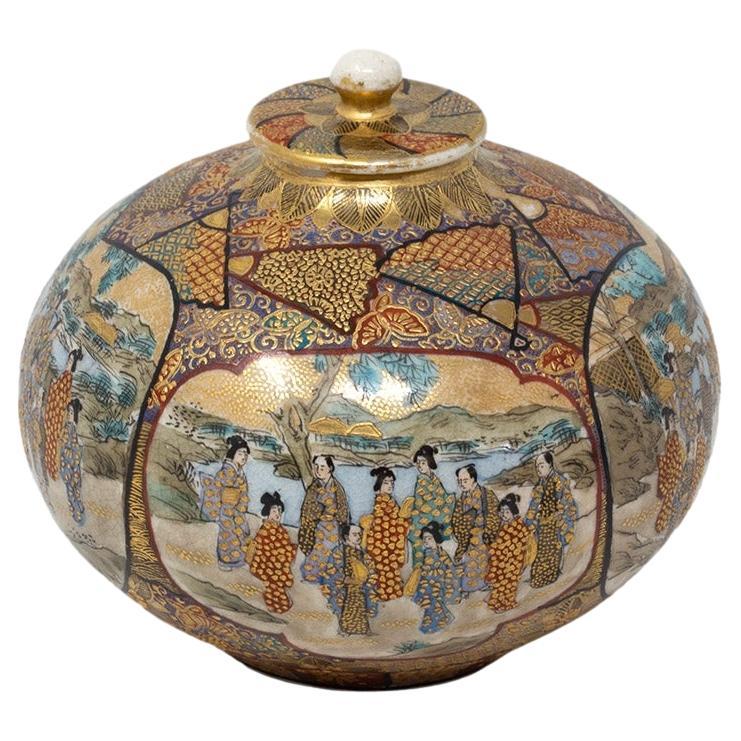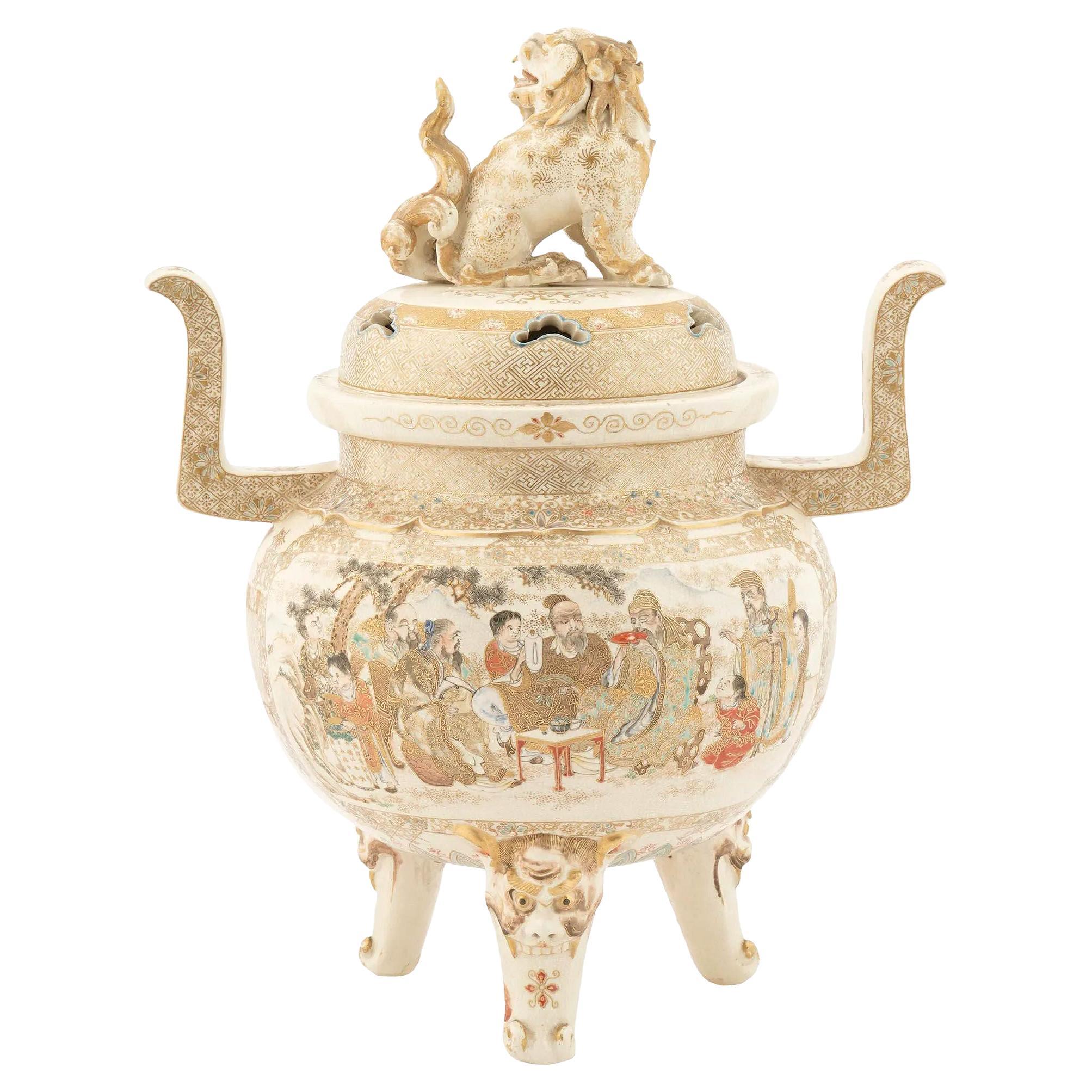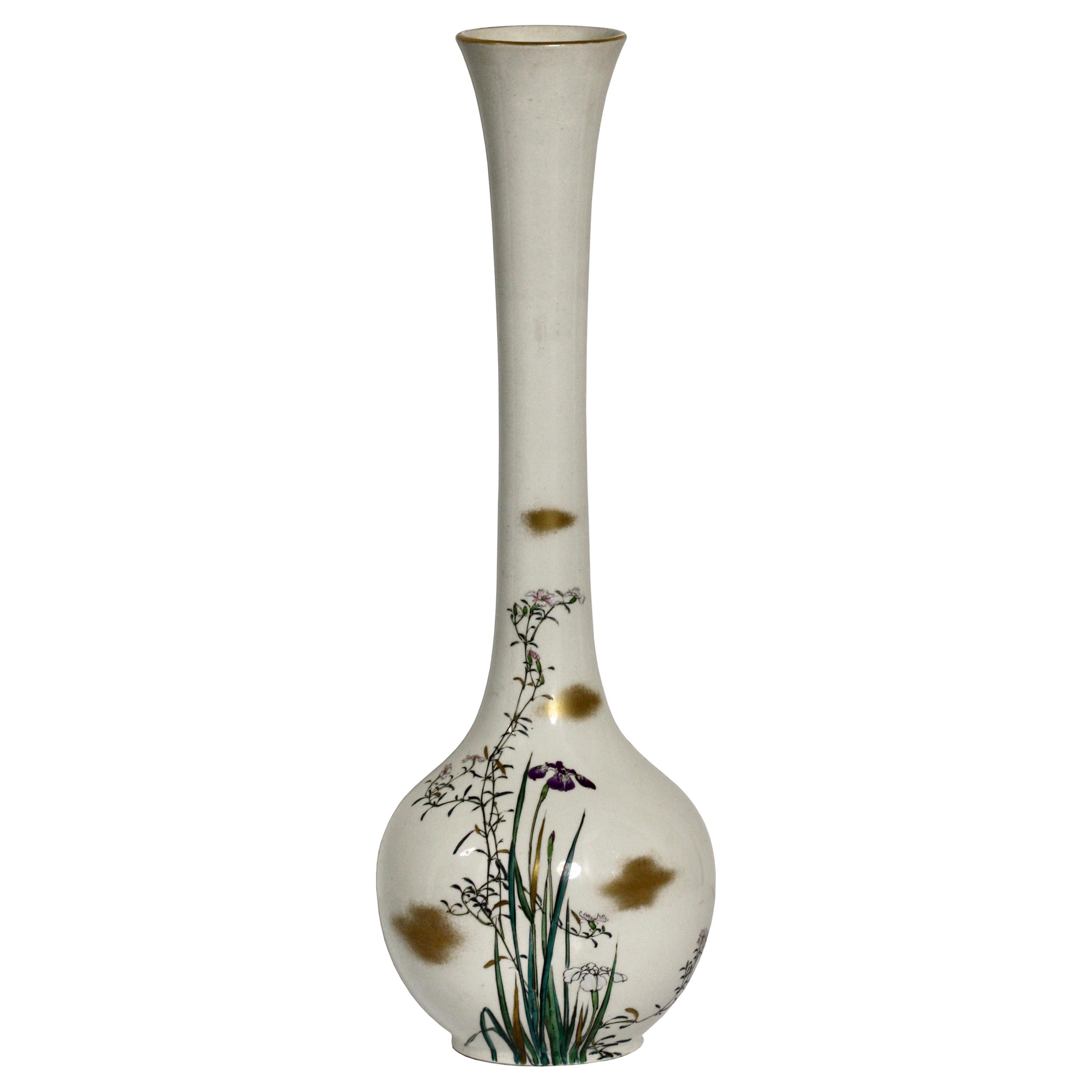Want more images or videos?
Request additional images or videos from the seller
1 of 10
Meiji Period Satsuma Patch Box
About the Item
This small detailed work made between 1890 and 1900 is skillfully painted representing a court lady in regal costumes being attended to by a small child carrying a bolt of silk cloth. This centered in a medallion where the raised decoration is heavily embellished with gold and patterned details. The round outer area is done in a cobalt blue with more goldwork designs and the interior of the box holds small painted objects as symbols of refinement and or beauty. The box is signed by the painter's hand but as yet we have not translated or matched it to a specific maker's work.
Wares of this type are most often produced in the city of Kagoshima in Kyushu province during the Meiji period and reflects the export industry designed to cater to western tastes but not particularly bought by Japanese citizens.
Patch boxes themselves became fashionable in the 17th and 18th centuries to store patches or beauty marks. These items made of gummed taffeta or some other fabric were used to conceal flaws such as pock marks or blemishes. They were also used to draw attention to specific details of one's face such as dimples. Patches came in a variety of sizes and specific shapes starting from a small dot and then moving on to stars, crescent moons, birds in flight, etc. They mostly could be found in black or brown but also came in brilliant colors. A further function was to make allusion to emotional states or conceived attributes a wearer wanted to express and a bewildering number of meanings could be associated with the location and specific shape a wearer choose that day. By 1796 the fashion for patches began to diminish with the introduction of the smallpox vaccination. In the later 19th century and into the early 20th century patches became a popular addition again to a woman's beauty products and so a resurgence of making boxes became popular.
Some slight wear to the gilding.
- Dimensions:Height: 1 in (2.54 cm)Diameter: 2.75 in (6.99 cm)
- Materials and Techniques:
- Place of Origin:
- Period:
- Date of Manufacture:1890
- Condition:Wear consistent with age and use.
- Seller Location:Hudson, NY
- Reference Number:1stDibs: LU811313033982
About the Seller
4.7
Vetted Seller
These experienced sellers undergo a comprehensive evaluation by our team of in-house experts.
Established in 1978
1stDibs seller since 2005
325 sales on 1stDibs
Typical response time: 23 hours
- ShippingRetrieving quote...Ships From: Hudson, NY
- Return PolicyThis item cannot be returned.
More From This SellerView All
- Japanese Porcelain Hibachi of the Showa Period or Slightly Earlier.Located in Hudson, NYThis porcelain Japanese hibachi or “Fire Bowl” was made in Japan circa 1900 to 1925. This is a traditional Japanese heating device and consists of a fireproof cylinder or box that ca...Category
Early 20th Century Japanese Showa Ceramics
MaterialsPorcelain
- Chinese Late Republic Period Bowl On Stand Decorated in Enamel ColorsLocated in Hudson, NYThis nice medium-sized bowl has underglaze and overglaze painted details and was made circa 1945 to 1950. It is decorated in an asymmetrical pattern of prunus and chrysanthemums with...Category
Mid-20th Century Chinese Ceramics
MaterialsPorcelain, Rosewood
- Chinese Ming period Dynasty Buddhist Incense Burner with a Rock Crystal FinialLocated in Hudson, NYThe Ming period or Great Ming Period is the last Han ruled dynasty in Chinese history. Considers a high mark culturally and influenced by great events at ho...Category
Antique 16th Century Chinese Ming Ceramics
MaterialsRock Crystal
- Period Large Han Dynasty Green Glazed Large Jar on 19th Century Rosewood StandLocated in Hudson, NYThis globular jar of a large size is traditionally called a Hu. Created in the Han dynasty and fully authenticated by the Chinese Government for the collective Group “Hong Kong Art C...Category
Antique 15th Century and Earlier Chinese Ceramics
MaterialsPottery, Rosewood
- Large Japanese Meiji Period Open Bronze CensorLocated in Hudson, NYThis cast bronze censor is from Japan and was made circa 1880. Raised up on three legs which issue from demons mouths the container is cast with reliefs ...Category
Antique Late 19th Century Japanese Meiji Metalwork
MaterialsBronze
- Chinese Qing Dynasty Large Monochrome Mieping Vase Mounted as a LampLocated in Hudson, NYThis very large Chinese Qing Dynasty monochrome Mieping vase with a Yongzheng reign mark mounted as a lamp is in a rich bottle green while marked with a Yongzheng (1722- 1735) reign ...Category
Antique 1880s Chinese Qing Table Lamps
MaterialsPorcelain
You May Also Like
- Japanese Satsuma Bowl, Meiji PeriodLocated in London, GBSigned, Meiji period (late 19th century), Decorated in various coloured enamels and lavish gilt on a blue ground with panels containing samurai, ladies in kimono, the interior with a...Category
Antique Late 19th Century Japanese Ceramics
MaterialsPorcelain
- Japanese Meiji Period Satsuma KoroBy KinkozanLocated in Newark, EnglandBulbous Form From our Japanese collection, we are delighted to offer this Japanese Meiji Period Satsuma Koro. The Japanese Satsuma Koro of rounded form neatly potted with a small to...Category
Antique Early 1900s Japanese Meiji Ceramics
MaterialsCeramic, Earthenware, Pottery
- Meiji Period Diminutive Satsuma Baluster Vase.By SatsumaLocated in Vero Beach, FLMeiji Period Diminutive Satsuma Baluster Vase. This Japanese Satsuma vase from the late Meiji period is hand painted and gilt decorated with a Japanese landscape in exquisite detail...Category
20th Century Japanese Meiji Ceramics
MaterialsPorcelain
- Japanese Meiji Period Satsuma Tripod CenserLocated in New York, NYVery fine quality Japanese Meiji period Satsuma tripod censer with a foo dog finial. wonderful painting quality.Category
Antique Late 19th Century Japanese Meiji Ceramics
MaterialsCeramic
- Kinkozan, Japanese Satsuma Vase, Meiji PeriodBy KinkozanLocated in West Palm Beach, FLKinkozan, Japanese Satsuma vase, Meiji Period (1868-1912) Of baluster form with an elongated neck decorated in polychrome enamels and gilt on a clear crackle glaze in an Art-Nouvea...Category
20th Century Ceramics
MaterialsCeramic
- Japanese Satsuma Earthenware Vase, Meiji PeriodLocated in West Palm Beach, FLJapanese Satsuma Earthenware Vase, Meiji Period, 1868-1912, of baluster form, the decorated in poly-chrome enamels and gilt on a clear crackle glaze with a Daimyo procession, the nec...Category
20th Century Ceramics
MaterialsCeramic





